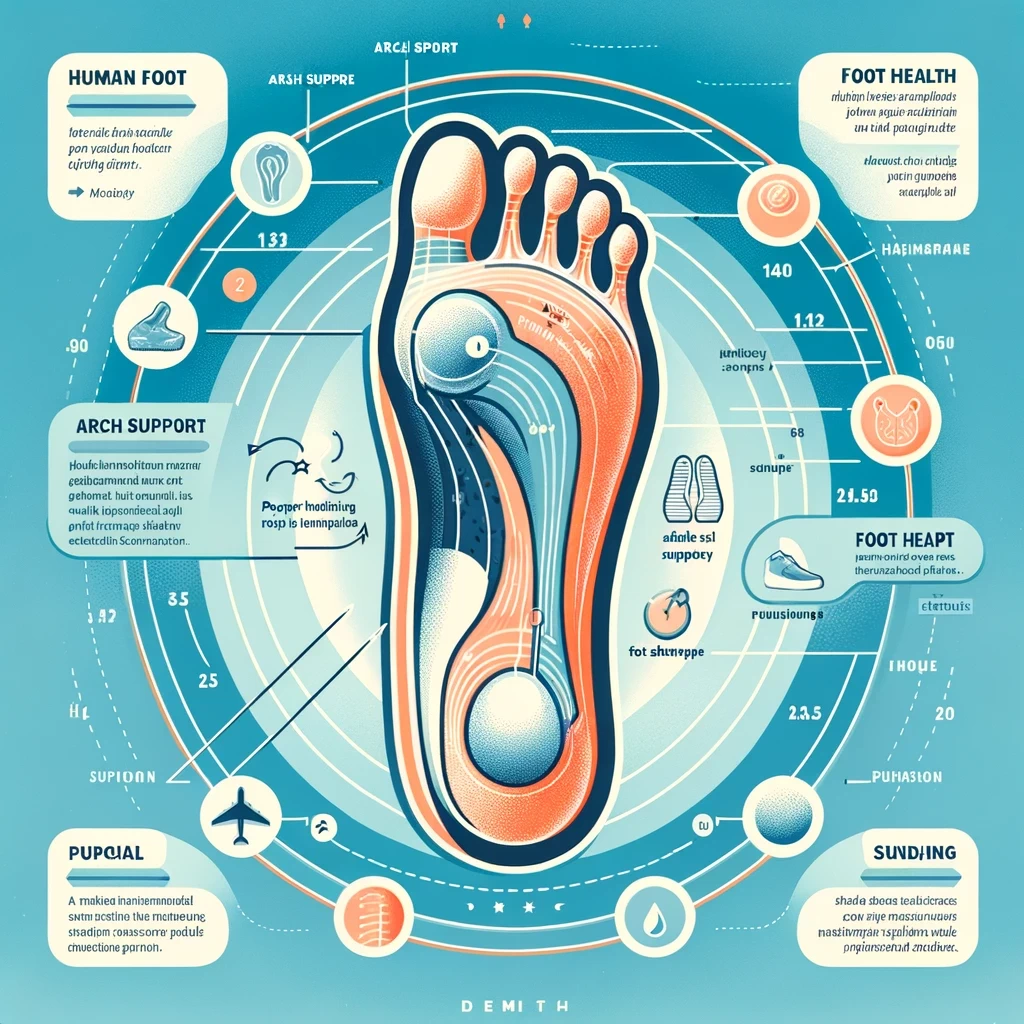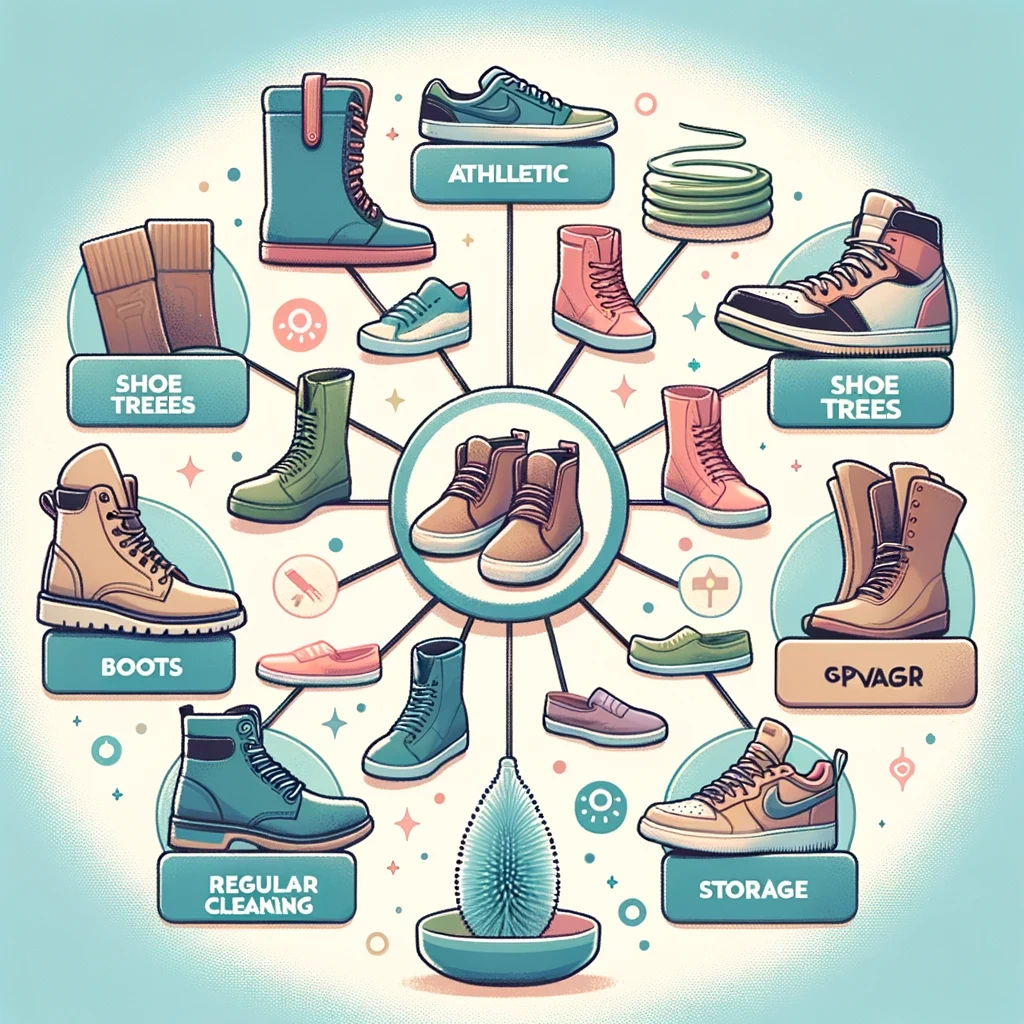Terrific Shoe Hacks: Surprisingly Boost Foot Health
Step Smart: Life-Changing Hacks for Choosing Shoes That Boost Foot Health
Introduction
Welcome! If you’re here, you are ready to treat your feet with the respect they deserve.
Often overlooked, our feet bear the brunt of our daily activities and yet we don’t frequently stop to consider how instrumental they are in our overall well-being. From the moment we rise out of bed in the morning until we retire at night, these marvels of form and function carry us through thousands of steps per day.
In doing so, they lay down the foundation for our physical health. Thus it is only fair that we take conscious steps (pun intended) to ensure their well-being.
The Unsung Heroes: Why Shoes Matter More Than You Think
So, where do shoes come into this picture? Well right at the forefront!
A good pair of shoes can be considered an investment into your foot health. They’re not just a fashion statement or a necessity but also a tool for protecting one’s feet from environmental hazards while providing essential support.
Ranging from cushioning your stride to preventing injuries – shoes play an integral part in maintaining foot health. They are akin to armour for your feet – shielding them from sharp objects, harsh weather conditions and uneven surfaces while providing much needed structural support for walking comfortably.

The Connection Between Footwear and Foot Health: An Overview
Every step you take sends a force roughly equal to 1.5 times your body weight through your foot and ankle. Now here’s food for thought – improper or ill-fitted shoes can exacerbate existing foot problems and even lead to new ones!
Inadequate arch support can cause or worsen flat fleet. High heels can lead to bunions or hammertoes by forcing toes into unnatural shapes over time.
Too-tight footwear? Welcome blisters, calluses, corns, and numbness.
So, your choice in footwear can mean the difference between stepping light with a spring in your step or hobbling home in pain. In a nutshell – good shoes equal great foot health.
It’s simple math. Stay tuned as we delve deeper into understanding our feet and making smart choices for different activities and lifestyles.
Understanding the Basics of Foot Health
Foot Anatomy 101: The Complex Marvel Underneath
When it comes to feet, many of us don’t fully grasp the complexity of this essential body part. Each foot is a biomechanical marvel, made up of 26 bones, 33 joints, and over a hundred muscles, tendons, and ligaments. There’s also an intricate network of blood vessels and nerves.
The combined orchestration allows us to walk, run, jump—essentially move with ease. It’s important to remember that each part has its own role in maintaining balance and supporting your body weight.
The arches distribute weight across the feet and align the foot with the lower leg. On the other hand, toes provide balance while heels absorb impact with each step we take.
Dancing with Dilemmas: Common Foot Problems Explained
Despite their remarkable design, our feet are prone to various complications— thanks mostly to factors like inadequate footwear and strenuous activities. Let’s look at two widespread issues: bunions and plantar fasciitis.
A bunion is a bony bump that forms on the joint at the base of your big toe—a result of some bones in your front foot moving out of place. Bunions often lead to discomfort or even pain as pressure increases on this deflected joint.
Notably—though fashionistas might wince at this—heeled shoes or those too narrow can aggravate bunions. On the flip side (or rather bottom) is plantar fasciitis—an inflammation of a thick band tissue (plantar fascia) that runs across your foot connects your heel bone to your toes.
It causes stabbing pain usually in your first steps in the morning—a nightmare for those passionate about morning jogs! Flat shoes with poor arch support can be prime culprits for this ailment.

Stepping Into The Shoe Universe: A Cosmic Array of Choices
When it comes to the world of shoes, it’s safe to say that we are spoilt for choice, and stepping into this universe can sometimes feel like navigating a labyrinth. From the unassuming flats and sneakers to the imposing high heels and boots, each type of shoe has its unique characteristics, with specific implications for our foot health. Sneakers, thanks to their ergonomic design and cushioned insides, offer an unparalleled level of comfort.
They are your feet’s best friends when you plan on doing a lot of walking or running. Heels on the other hand, while they may add pizzazz to your outfit or give your height an impressive boost, fail in offering ample support or alignment for your feet if worn for prolonged periods.
Hence they should be reserved for special occasions rather than everyday use. Flats might seem like a safer option compared to heels but don’t be surprised if they’re not as benign as you’d think.
Ballet flats often lack necessary arch support which can lead to problems like plantar fasciitis or heel pain over time. An optimal choice would be loafers or brogues which combine style with comfort marrying aesthetics with practicality.
Finding Your Sole Mate: Why Material Matters
Now that we’ve decoded some popular shoe types let’s delve into another crucial aspect – the material your shoes are made from. This is no trivial matter; rather it could very well determine whether your shoes end up being a boon or bane for your feet.
Step forth leather – a classic favorite in shoemaking due its durability and ability to mold around our foot shape over time providing excellent fit and comfort. Not only does it have breathability but also resists fungal growth making it perfect for people who have sweaty feet!
However, leather might not always be the most feasible option. In such cases, synthetic materials like canvas, faux leather or nylon can come in handy.
They’re lightweight and easy to maintain. However, be wary of the lack of ventilation which might result in sweaty feet or worse – fungal infections.
Then there are materials used for the insoles and midsoles such as EVA (Ethylene Vinyl Acetate), Polyurethane and gel that provide excellent cushioning while absorbing shock as you walk or run. So next time you’re out shoe shopping, remember to flip the shoe around and take a peek at what lies beneath!
Making Smart Choices for Different Activities
The Sprinter’s Survival Guide: Choosing the Right Sneakers for Joggers
Those who frequent the loping trails know well that not all sneakers are crafted with the same intent. The running shoe realm is replete with options that cater to a medley of foot types, gaits, and terrain preferences. When choosing running shoes, it’s essential to discern your foot type: Are you flat-footed?
High-arched? Or perhaps you possess a neutral arch which- lucky you!- makes shoe shopping a tad less complicated.
There’s also the matter of pronation—the way your foot rolls inwards as it hits the ground—to consider. Overpronators (whose feet roll excessively inwards) would benefit from motion-control or high-stability shoes, while underpronators (with feet rolling little to none) would find solace in cushioned shoes that provide shock absorption.
Step-by-step Elegance: Best Picks for Daily Strolls
Stroll-friendly shoes may not necessitate as much precision picking as their running counterparts, but that doesn’t mean you can slip into any random pair and deem it ‘good enough’. Comfort is key here— your chosen pair should cradle your heel snugly while providing ample space for toes to wiggle. Look out for flexible soles that bend easily at the ball of your foot and skip those that only twist at the arch— they’re not doing your feet any favors!
Let’s give a nod to supportive arches too; whether you’re hopping on errands or meandering through city streets, they will bear weight and alleviate pressure on your joints effectively. And remember: although flats seem like an obvious choice for walking, an entirely flat shoe provides little support—opt instead for low heels.
Swaying Towards Foot Safety: Selecting Shoes That Won’t Kill Your Feet on the Dance Floor
It’s a triumphant night—you’ve spun, glided, and tapped your way across the dance floor. But beneath those bedazzled feet is a woeful tale of blisters and pain brewing. Kick off those torturous heels and listen up, dancing queens (and kings): you need not sacrifice comfort for style anymore!
Dance shoes should be flexible but offer good support, especially in the arches. The best pairs have suede or leather bottoms that allow just enough glide but still prevent slipping.
For higher stability during those energetic jives or swaying waltzes, look for shoes with ankle straps or T-bars with a heel height you can manage comfortably— usually between 1 to 2 inches. And remember: no shoe should require a ‘breaking in’ period—if they’re not comfortable when you buy them, they’re not the right dance shoes for you.
Age-Specific Considerations in Shoe Selection
The First Steps: Ensuring Proper Foot Development with Good Shoes
From the moment your little bundle of joy takes their first wobbly step, footwear becomes a significant part of their lives. The shoes they wear should not only provide protection but also support the natural growth and development of their feet. A child’s foot is malleable and soft, almost like play-dough, and can easily be misshaped by ill-fitting shoes at this stage.
Therefore, it’s critical to choose shoes with room for growth that won’t cramp their tiny toes. Remember, our tiny tots are discovering a new world every day – running, jumping, skipping – and their footwear should be able to keep up!
Always opt for breathable materials like leather or canvas to prevent sweaty and smelly feet. A flexible yet firm outsole presents an ideal balance between comfort and support.
Teenage Dream: Balancing Style and Comfort During Growth Spurts
The teenage years can be quite a challenge when it comes to shoe selection. With constant growth spurts altering shoe size in conjunction with an increased interest in fashion trends, finding the right balance between style and comfort can seem like a Herculean task.
However, it’s not impossible! The key is flexibility – both literally in the shoe structure for accommodating growing feet and metaphorically in style options for appeasing teen aesthetics.
Also worth considering during this phase is that many sports-related foot injuries occur during adolescence due to poor shoe choices or worn-out footwear. So don’t forget to replace those basketball sneakers or ballet flats regularly!
Walking Tall: Maintaining Foot Health as You Age
As we transition into adulthood and old age, our feet often bear the brunt of decades of stress from standing, walking, running, and occasional shoe-related blunders. Foot disorders become more common, and wearing the wrong shoes can exacerbate existing conditions or even cause new ones.
Aging feet require shoes that provide not just comfort but also superior support and cushioning, especially in the arch and heel area. High-quality materials that allow for breathability are a must to avoid fungal infections or other foot issues.
Prioritizing functionality over fleeting fashion trends can go a long way in preserving your foot health as you age. And remember: the right shoe doesn’t just fit your foot; it fits your lifestyle too.
Special Circumstances & Shoe Choices
Happy Feet for Diabetics – Specialized Shoes for Better Comfort and Safety
Living with diabetes often means living with the daily reality of careful blood sugar management and attentive healthcare practices. Among these considerations, foot health can sometimes be overlooked. However, it is important to understand that diabetic individuals can experience a range of foot problems like neuropathy, poor circulation, and increased risk of infection.
Choosing the right footwear can make all the difference in protecting your foot health when you have diabetes. Opting for specialty diabetic shoes or therapeutic footwear can significantly enhance comfort and safety.
These shoes are typically deeper and wider than regular shoes, providing extra room to accommodate orthotics or insoles if needed. They also feature non-binding uppers to reduce pressure on the feet – a boon for those prone to sores or ulcers due to decreased sensation.
Pregnancy Patter – How Swelling Changes Your Shoe Needs
When it comes to pregnancy, almost every aspect of a woman’s body undergoes change – including her feet! Edema, or swelling in the lower extremities, is common during pregnancy due to increased fluid retention and blood flow.
This change often leads expectant mothers on a quest for comfortable footwear that accommodates this temporary increase in foot girth without sacrificing style. During this special period, foot size may increase by up to one full shoe size!
Choosing lightweight shoes with breathable fabrics helps manage heat which often exacerbates swelling. Shoes with adjustable straps offer flexibility as your feet change throughout the day.
Supportive soles are key too – they’ll provide stability while cushioning those tired arches! Remember: high heels might be tempting but during pregnancy they’re best left on the shelf – your center of gravity shifts when you’re expecting which could lead to balance issues.
Shoe Shopping Tips & Tricks
Size Matters – How to Ensure a Perfect Fit Every Time
As the adage goes, ‘If the shoe fits, wear it’. But how do you ensure this proverbial fit?
When it comes to shoe shopping, size is both an art and science. Shoes that are too large can cause blistering and instability while those that are too tight can lead to bunions, corns, and other foot disorders.
Here’s your magic formula: your shoes should fit your feet comfortably right from the moment you put them on — no ‘breaking in’ phase necessary. The best time to shop for shoes is in the late afternoon or evening as our feet tend to swell over the course of the day.
Always have both of your feet measured because they may not be exactly the same size. And don’t forget about width!
Feet are three-dimensional entities; length isn’t everything. A shoe that is ideal in length but narrow for your foot will still lead to discomfort and potential foot issues.
Bargain or Bust? – Deciphering When It’s Worth Splurging on Expensive Brands
Navigating between high-end designer labels and affordable street brands can feel like being stuck between a rock and a hard place (or should we say, a stiletto heel and flip flop?). Contrary to popular belief, price does not always equate quality. There are plenty of costly shoes that prioritize appearance over ergonomic design.
However, reputable brands often justify their steep prices with state-of-the-art features such as superior cushioning systems or high-quality materials that guarantee durability. In contrast, bargain shoes primarily focus on cutting costs at all stages of production – often at the expense of comfort and longevity. The general rule here is: prioritize quality over quantity! A few pairs of well-made shoes will serve you better and longer than a closet full of ill-fitting, cheap ones. Remember, when investing in shoes, you’re investing in your foot health.
Caring For Your Chosen Kicks: Don’t Just Wear, Show Care
Shoes are our faithful companions in the journey of life, and like any good relationship, they require care and attention to flourish. Maintaining your shoes does not only enhance their aesthetic appeal but also significantly extends their life span.
The simplest act of cleaning after use can salvage your shoes from premature aging; keep them free from grime, dirt or stains. Do remember to air out the insides as well; it’s a quick remedy against odors and bacteria.
Material-specific care is an often overlooked aspect that could be the turning point in your shoe-care routine. Leather shoes love a good polish, while suede ones enjoy a gentle brush-up now and then.
Don’t forget waterproofing treatments for your rain boots or any other water-prone footwear. They’ll thank you for it during inclement weather.

Prolonging the Life of Your Shoes: Every Step Counts
Proper storage can be a lifesaver for your favorite pair of kicks – every shoe deserves its downtime! Store them properly to retain their shape; shoe trees or stuffing with newspapers works wonders. Keep them away from direct sunlight to avoid discoloration and drying out of certain materials like leather.
Rotating your footwear is another pro tip worth adopting – giving each pair a break not only evens out wear but also allows sufficient ‘breathing time’. Consider investing in quality repair services too when required – sometimes all it takes to renew that worn-out boot is a professional touch.
Conclusion: Walking into Healthier Horizons
Undeniably, choosing the right shoe can be transformative – opening doors to improved foot health, greater comfort, and even enhanced self-confidence! So next time you’re shopping for that perfect pair or considering skipping on your shoe-care routine, remember – every step you take is a chance to step smart. It’s a fascinating journey of discovery, one where the destination is as enticing as the journey itself – a lifetime of foot-friendly choices and countless comfortable strides!
Happy Feet Toolkit: Essentials for Footwear Wisdom
Elevate your foot health with our selection of top-tier resources designed to guide your shoe choices for comfort and well-being. “The Shoe Bible” by Dr. Jane Andersen offers comprehensive insights into selecting the best footwear for various foot conditions. For those on-the-go, the Superfeet Green Insoles provide enhanced support, transforming your favorite shoes into bastions of comfort.
Explore the website FootwearNews.com for reviews on the latest in shoe technology and health-focused design trends. The “Foot Doctor Zach” YouTube channel dives into the anatomy of shoes and their impact on foot health, providing visual tips on what to look for in your next pair. And for customized shoe-fitting experiences, check out the Dr. Scholl’s Custom Fit Kiosk Locator online to find personalized insole recommendations. Armed with these goods and knowledge hubs, you’re well on your way to making informed, foot-friendly decisions in the shoe aisle.
Engage & Share
Did you find this article helpful? We’d appreciate hearing your perspective. Share your experiences in the comments; your insights might help others on their journey. And if this article could help your friends or family, please share it on social media. Every share contributes to spreading useful information and creating a community focused on achieving a harmonious home. Let’s connect and inspire each other!
